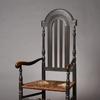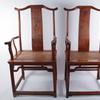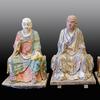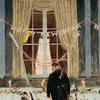Cantor Exhibition Presents Rarely Seen Warrior’s Visual Account of Famous Battle With General Custer
- STANFORD, California
- /
- November 16, 2015
Red Horse: Drawings of the Battle of the Little Bighorn, January 16–May 9, 2016
Stanford, Calif.—The Cantor Arts Center at Stanford University announces a rare exhibition of 12 drawings by acclaimed ledger artist Red Horse, a Minneconjou Lakota Sioux warrior who fought against George Armstrong Custer and the 7th Cavalry at the Battle of the Little Bighorn in June 1876. Red Horse: Drawings of the Battle of the Little Bighorn brings together key collaborators from Stanford and its communities to explore these indigenous-centered illustrations from diverse perspectives. The Cantor’s exhibition marks the first time that a representative selection of these remarkable works has been displayed together since the 100th anniversary of the Battle of the Little Bighorn in 1976. The drawings are on loan from the National Anthropological Archives, Smithsonian Institution.
“This exhibition, with singular works from the Smithsonian Institution’s acclaimed archives combined with the expertise of Stanford-affiliated scholars, supports new interdisciplinary approaches to art and culture here at Stanford,” said Connie Wolf, the John and Jill Freidenrich Director of the Cantor Arts Center. “This collaborative project illuminates unique and essential new understandings of this critical moment in history.”
Immersive Student Learning and Collaborative Curatorial Vision
For the past five years, Scott D. Sagan, the Caroline S. G. Munro Professor of Political Science at Stanford University, Senior Fellow at the Freeman Spogli Institute for International Studies and Senior Fellow at the Center for International Security and Cooperation, has taught a popular Sophomore College seminar at Stanford University that explores “The Face of the Battle.” In his intensive three-week-long course, students examine two key battles, Gettysburg and the Battle of the Little Bighorn, from the perspectives of participants on the ground. As part of their assignment, each student researches two historical figures in depth before traveling to both sites. Once there, they walk the battlefields and brief their classmates (in character as historical figures) at key moments and locations about the decisions they made before, during and after the battle. To enhance their understanding of what occurred at Little Bighorn, Prof. Sagan takes the students to the Smithsonian, where JoAllyn Archambault (Yanktonai and Muscogee), Director of the American Indian Program at the National Museum of Natural History, teaches them about the Lakota perspective on the Battle using Red Horse’s ledger drawings.
When Prof. Sagan’s Sophomore College students encountered Red Horse’s powerful works firsthand, their responses were profound. Sarah Sadlier (Minneconjou), History, American Studies, Iberian and Latin American Cultures ’16, whose ancestor “Big Leggins” Bruguier was an interpreter for Sitting Bull and present in the Little Bighorn camp the day the fighting began, took the course two years ago and found the experience both empowering and emotional. For Sadlier, “seeing the drawings and walking the battlefield humanized the participants in a way that helped me understand their decision-making as well as both the glory and horror of war.” The immersive learning environment fostered by Prof. Sagan ignited in his students a passion that continues to drive their pursuit of knowledge: Sadlier, along with many others from the class over the years, decided to pursue a related major so that she could continue studying such topics at greater length.
Inspired by the enthusiasm of the Sophomore College students, Prof. Sagan and Connie Wolf partnered to explore the possibility of bringing such a valuable learning opportunity to the wider Stanford community. The result of their idea, and the generous work of the Cantor’s expert collaborators, became Red Horse: Drawings of the Battle of the Little Bighorn, a project that highlights the dynamic ways that art objects open up new avenues of inquiry and opportunities for dialogue when examined from multiple perspectives. Leading up to and into winter and spring 2016, the exhibition will serve as a site of cross-disciplinary inquiry and exchange for courses across the university, including, among others, studies of the American West, International Security in a Changing World and the Lakota language.
Ledger Drawings and Red Horse’s Work
The indigenous peoples of the Great Plains of North America have an enduring history of pictorially recording important moments in their lives, such as men’s successes in war and hunting. Prior to the 19th century, rock walls, tipis and hide garments were the primary canvases for such chronicles. With the influx of European settlers in the 1830s and ’40s came new materials that were adapted to serve this longstanding artistic tradition. The “ledger drawing” genre, which flourished between 1870 and 1900, takes its name from the popular bound books used by traders and military men to keep track of inventory: the books’ pages were one of the main sources of paper that became available to artists. Using pens, pencils, colored pencils and watercolors, Plains men made drawings for themselves, their communities and a rapidly expanding external market.
The 12 drawings featured in the Red Horse exhibition were selected from a larger group of 42 commissioned by Army doctor Charles E. McChesney at the Cheyenne River Agency in 1881. The warrior artist created the drawings and gave testimony about his experiences at the Battle of the Little Bighorn in conjunction with Garrick Mallery’s study of Plains sign language, published in 1893. Renowned for their large scale and exceptionally powerful imagery, Red Horse’s illustrations feature scenes that include combat on horseback, wounded and dead warriors, horses, and soldiers as well as Native Americans leaving the battlefield. More than a century after their creation, they continue to function as an extraordinary artist’s narrative of this important moment in American and Native American history.












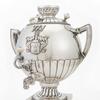

_-Closing-the-Distance_100x100_c.jpg)



